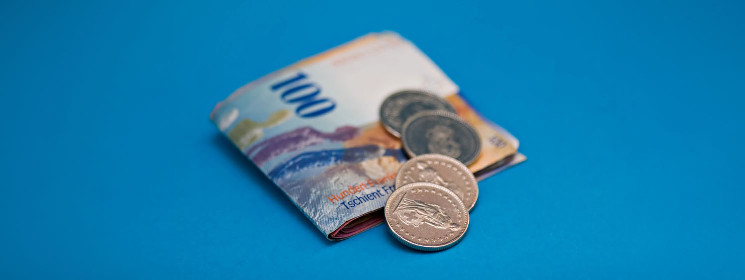While the Swiss National Bank (SNB) is steamrolling with its experiments on a central bank digital currency (CBDC), the latest reports indicate that the banking regulator will adopt a cautious approach in rolling out SNB Bills.
In an economic note, the central bank stated that rolling out digital SNB Bills to be settled in wholesale CBDCs has indicated early promise for participants. However, the paper notes that including the process in monetary policy may open a whole new can of worms for the SNB and other financial institutions in the country.
The study involving digital SNB Bills forms part of Helvetia III, the third phase of the SNB’s pilot project involving using CBDCs for tokenized asset settlement. SNB Bills are short-term debt register claims issued by the SNB to absorb liquidity, reduce reserve volumes, and increase pressure on money market rates.
While operating in the same manner as the traditional offerings, digital SNB Bills rely on blockchain technology for its basic architecture, with the central bank identifying a streak of positives in addressing liquidity issues.
SNB noted that issuing digital SNB Bills was a seamless process, strikingly similar to issuing digital bonds on the SDX platform. The central bank noted that since the digital SNB Bills will be used for monetary policy, deploying it in Helvetia III is a step in the right direction.
Despite the apparent difference in leaning on blockchain as the base layer, the digital SNB Bills still differed from their traditional counterparts in several ways. For starters, the central bank opted for a private placement for issuance, working with a close-ended group of participants rather than a wider group.
Unlike the conventional SNB Bills Program, the SNB pegged the redemption period at seven days, and its auction was carried out outside the traditional electronic trading platform.
Despite the benefits marshaled out by the central bank, the economic note reveals several glaring concerns associated with the full-scale implementation of the digital SNB Bills. Critics argue that the niche nature of blockchain-based markets and the absence of a deep pool of participants makes its use in monetary policy “premature.”
“Ramping up such operations would also entail significant investment for the SNB, its counterparties as well as infrastructure providers and, in the current environment, stands in contrast to a lean monetary policy operational framework,” read the report.
The insights gained during the pilot will be key in assisting the central bank in rolling out regulations to integrate blockchain-based solutions for monetary policy in the coming months.
SCB experiments with stablecoins in government regulatory sandbox
Thai-based SCBX Group and its subsidiaries are exploring the viability of stablecoins in local and international settlements, leaning on the lessons gleaned from its Southeast Asian counterparts.
According to a report, SCB 10X, the fintech arm of the financial giant, is leading the stablecoin studies in partnership with its digital bank unit, Siam Commercial Bank. SCB 10X has developed a stablecoin pegged to the Thai Baht, dubbed THBX, which is designed to complement and not replace cash.
The stablecoin offerings come with a wallet solution for users dubbed the Rubie wallet, with company executives noting that the solutions have the blessings of financial regulators. Both offerings are part of a regulatory sandbox instituted by the Thai Securities and Exchange Commission (SEC) and the central bank.
SCB 10X CEO Mukaya Tai Panich disclosed to reporters that by participating in the sandbox, THBX will not be plagued by the usual frictions plaguing stablecoin offerings in the country. The CEO is eyeing a commercial launch in the coming months, but it remains unclear if the stablecoin will be used for local transactions.
“At SCB 10X, we believe that participating in BOT and SEC regulatory sandbox will be a significant move for financial innovation to global financial inclusion as well as the Thai digital asset ecosystem,” said Panich.
For now, the stablecoin can only be used by foreign participants at the Ethereum Devcon summit in Thailand with over 100 merchants approved to accept THBX. Early functionalities for THBX include QR codes, micropayment, and advanced programmability akin to Purpose Bound Money studies in Singapore.
“THBX is designed to provide international visitors with a seamless payment experience, and we are proud to be at the forefront of this transformation in Thailand’s digital economy,” added Panich.
By soft launching THBX at Ethereum Devcon, any glitches will be easy to maneuver, given the tech-savvy nature of attendees of the developer conference. Furthermore, by limiting its use to foreigners, SCB 10X can stress test THBX’s cross-border capabilities before a commercial rollout.
With safety and accessibility in mind, SCB 10X puts a premium on ease of use for foreigners keen on interacting with the stablecoin. Users simply have to download the SCB 10X Wallet and complete a Know Your Customer (KYC) process before swapping USDC for THE BX on InnovestX.
After launching a digital asset sandbox in mid-2024, the local ecosystem in Thailand has been buzzing with activity. The nation recorded its first approved stablecoin in October while rolling out a trial for programmable digital asset payment amid plans for a seismic digital asset handout to citizens.
Watch: Finding ways to use CBDC outside of digital currencies
 coingeek.com
coingeek.com
